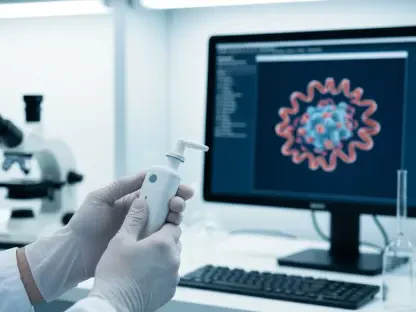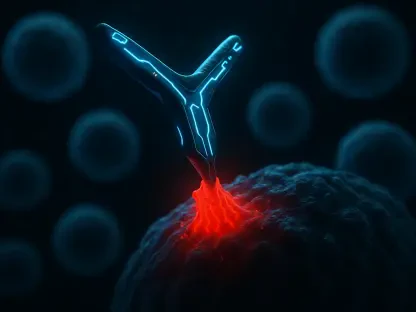Over the past few decades, the intersection of nanotechnology and medicine has forged an unprecedented pathway for addressing some of the most challenging issues within healthcare. With a predicted robust growth rate and a series of transformative opportunities on the horizon, the global nanomedicine market is set to redefine how medical conditions are diagnosed, treated, and even prevented. By operating at the molecular level, nanomedicine aims to advance drug delivery systems, revolutionize imaging techniques, and spearhead the development of novel therapies. This technological leap promises a more targeted approach to treatment and early disease detection, pushing the boundaries of personalized medicine and regenerative therapies.
Market Forces Driving Nanomedicine
Influence of Nanotechnology R&D and Chronic Disease Prevalence
Nanomedicine’s growth is heavily influenced by the ever-evolving landscape of research and development in nanotechnology; substantial investments are being funneled into this domain by both governmental agencies and private enterprises. As chronic diseases, such as cancer and cardiovascular ailments, continue to escalate, the demand for innovative healthcare solutions increases concurrently. Such conditions necessitate advanced medical interventions that can provide precise treatment while minimizing adverse effects. Nanomedicine’s ability in this regard is particularly noteworthy, as it offers targeted delivery systems that mitigate many of the side effects traditionally associated with treatment, such as chemotherapy.
The simultaneous rise in the global aging population further propels the nanomedicine market. Elderly individuals are more prone to chronic diseases, increasing the need for sustained and effective treatment strategies. This demographic shift places additional pressure on healthcare systems to provide tailored solutions which nanomedicine appears well poised to address. Despite its potential, the field is not without its challenges, including high development and manufacturing costs, regulatory complexities, and concerns regarding the safety and toxicity of nanoparticles. Nevertheless, the ongoing advancements in this area continue to stimulate interest and investment.
Regulatory and Financial Hurdles
Despite the promising outlook, the nanomedicine market encounters a labyrinth of regulatory and financial barriers that could impede its growth trajectory. The sophisticated nature of nanoscale materials introduces complexities in regulatory frameworks, as traditional guidelines often fall short of adequately addressing the intricacies of these advanced solutions. Regulatory agencies across the globe are challenged with developing appropriate protocols to evaluate the safety and efficacy of these interventions, which can translate to prolonged approval processes and additional hurdles for market access.
Furthermore, the high costs associated with the research, development, and manufacturing of nanomedicines constitute significant financial barriers. These costs are often transferred to healthcare systems and patients, potentially limiting accessibility and adoption. As stakeholders navigate these challenges, collaboration between industry leaders, researchers, and policymakers becomes increasingly essential to establish more streamlined regulatory processes and foster an environment conducive to innovation. Despite these hurdles, the considerable potential benefits of nanomedicine serve as powerful motivators encouraging continued exploration and investment in this transformative field.
Nanomedicine in Drug Delivery
Enhancing Drug Delivery Techniques
Nanomedicine has made significant strides in advancing drug delivery techniques, addressing many of the limitations posed by traditional methods. By engineering nanoparticles that can deliver therapeutic agents directly to specific cells or tissues, these technologies enhance therapeutic effects while mitigating unwanted side effects. This precision drug delivery is particularly beneficial in treating complex diseases such as cancer and neurological disorders, where conventional therapies often fall short of achieving targeted results. Nanoparticles can be engineered with properties that enable them to navigate biological barriers and deliver drugs effectively to hard-to-reach locations within the body, maximizing therapeutic efficacy.
Moreover, nanomedicine is capable of enhancing drug stability and bioavailability through mechanisms such as controlled and sustained drug release. These features lead to more consistent therapeutic outcomes and can reduce dosing frequencies, which subsequently improve patient compliance. The potential for personalization in treatment regimens is another unique advantage of nanomedicine as these delivery systems can be customized to account for individual patient differences, thereby optimizing therapeutic results. This aligns with the broader trend in healthcare toward more personalized medicine approaches, emphasizing tailored treatments that account for a patient’s specific genetic makeup and health needs.
Addressing Challenges in Design and Development
Despite significant progress in the development of advanced drug delivery systems, challenges remain in the design and production of nanoparticles for medical applications. One of the primary concerns is the potential toxicity and long-term side effects of nanoparticles when introduced into the human body. While efforts are being made to engineer biocompatible and biodegradable nanoparticles, rigorous studies are essential to fully understand their interaction with biological systems and ensure patient safety. Overcoming these challenges will require continuous advancements in nanotechnology, combined with thorough preclinical and clinical evaluations.
In addition, the complexity of producing nanoparticles at a commercial scale presents logistical and manufacturing challenges. The precise fabrication required to maintain consistent quality and performance at large volumes demands innovative production methods and strict quality controls. As the field progresses, leveraging cutting-edge manufacturing techniques such as microfluidics and additive manufacturing could help address these issues. Collaboration between researchers and industry experts will be crucial in overcoming these barriers, enabling widespread access to the potential benefits of advanced nanomedicine drug delivery systems.
The Role of Nanomedicine in Chronic Disease Management
Precision Medicine and Early Diagnosis
The increasing incidence of chronic diseases has elevated the need for advanced medical interventions capable of offering more effective treatment options. Nanomedicine plays an integral role in this landscape by facilitating precision medicine, which emphasizes individualized treatment tailored to a patient’s specific genetic and phenotypic characteristics. Utilizing nanoparticles allows for more targeted drug delivery, ensuring active agents reach the desired site of action with minimal off-target effects. This targeted approach can be particularly advantageous in managing conditions like cancer, where minimizing damage to healthy cells is crucial for effective treatment and improving patient quality of life.
Additionally, nanomedicine significantly contributes to early diagnosis and disease monitoring through advanced imaging and biosensing technologies. Nanotechnology-driven innovations have led to the development of high-resolution imaging techniques and biosensors capable of detecting diseases at their early stages. By enabling earlier detection, these tools empower healthcare providers to initiate interventions sooner, thereby potentially improving outcomes for patients with chronic diseases. This preventative approach aligns with the ongoing shift towards value-based care, which emphasizes outcomes, cost-efficiency, and patient-centered approaches.
Challenges and Opportunities in Chronic Disease Intervention
Despite the opportunities presented by nanomedicine in chronic disease management, certain challenges must be navigated to fully harness its potential. The complexity of chronic diseases, often involving multifactorial causes and differing manifestations between individuals, requires highly adaptable and dynamic therapeutic strategies. Nanomedicine, with its ability for targeted and personalized intervention, is well-positioned to address these intricacies, yet significant clinical testing and validation are necessary to establish its efficacy and safety comprehensively. Building a robust body of evidence through clinical trials will be essential to gaining the trust of healthcare providers and facilitating broader adoption.
Moreover, the integration of nanomedicine into existing healthcare systems poses logistical and cost-related challenges. Effective implementation requires significant investment in both infrastructure and training to ensure healthcare providers can competently utilize these advanced techniques. Efforts must also be directed towards addressing issues of cost-effectiveness, as the high expenses associated with nanomedicine development may limit accessibility and affordability for patients. Nonetheless, the promising prospects offered by nanomedicine in chronic disease management continue to drive interest and investment, with the potential to significantly transform patient care and outcome, presenting a paradigm shift in how chronic conditions are managed moving forward.
Strategic Directions for Growth
Collaboration and Innovation in the Industry
In the pursuit of establishing a strong foothold in the burgeoning nanomedicine market, industry leaders are increasingly adopting growth strategies centered around collaboration, innovation, and strategic partnerships. These efforts manifest in various ways, from pooling resources to drive research and development breakthroughs to forming alliances aimed at expanding market reach and influence. Collaborative endeavors often involve partnerships between pharmaceutical companies, research institutions, and technology firms, enabling stakeholders to leverage diverse expertise and capabilities to accelerate nanomedicine advancements.
Nanomedicine companies are also focused on launching new products and expanding their portfolios to address a broader spectrum of medical needs. These initiatives often involve tailoring innovative solutions to target diseases with high unmet needs or limited treatment options, thereby tapping into niche market segments. Companies recognize that staying ahead in this rapidly evolving industry demands a commitment to innovation, driving them to invest heavily in developing next-generation nanomedicine applications that offer new levels of precision and efficacy in medical treatment.
Competitive Landscape and Future Prospects
The competitive landscape of the nanomedicine market features key industry players such as Thermo Fisher Scientific, Sanofi, Bristol Myers Squibb, and Pfizer. These companies are actively involved in research, development, and commercialization activities within the nanomedicine domain, jockeying for leadership positions in a dynamic and rapidly expanding field. Market differentiation is often achieved through strategic initiatives, such as obtaining patents for novel technologies, pioneering innovative treatment modalities, and engaging in mergers and acquisitions to bolster resources and capabilities.
Looking ahead, the future of nanomedicine appears highly optimistic. As awareness of its potential benefits continues to grow among healthcare practitioners and patients, acceptance and adoption are expected to rise. This trajectory is further reinforced by an environment increasingly supportive of personalized medicine and advanced therapeutic solutions. However, realizing this potential will require sustained investment in research, addressing regulatory hurdles, and ensuring affordability and accessibility to facilitate broader market penetration. Strategic partnerships and a commitment to innovation remain pivotal in overcoming challenges, driving the vision of nanomedicine as a core component of the future healthcare paradigm.
Embracing the Future of Nanomedicine
In recent decades, the convergence of nanotechnology and medicine has created an innovative path for tackling some of healthcare’s toughest challenges. This fusion has led to predictions of strong growth and groundbreaking opportunities within the global nanomedicine market, potentially transforming the ways in which we diagnose, treat, and prevent medical conditions. By focusing on the molecular level, nanomedicine seeks to enhance drug delivery systems, revolutionize imaging methods, and foster the creation of new therapies. This technological advancement offers a more precise approach to treatment by enabling early disease detection and tailored healthcare solutions, thereby pushing the limits of personalized medicine and regenerative therapies.
One of the core benefits of nanomedicine is its ability to deliver drugs directly to targeted cells, which minimizes side effects and increases treatment efficacy. This precision enhances the capability to manage complex diseases like cancer more effectively. Additionally, nanotechnology-based imaging techniques provide more detailed and accurate views inside the body, leading to quicker and more reliable diagnoses. As research progresses, nanomedicine will continue to expand its influence across various medical fields, offering innovative solutions that hold the potential to improve patient outcomes significantly. In essence, this powerful blend of technology and medicine is set to redefine the future landscape of healthcare.









